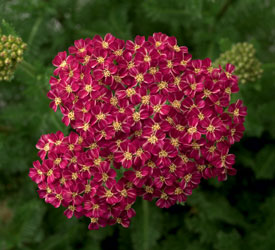9/30/2015
To Cool or Not to Cool? That is the Question …
Beth Engle

Exposing herbaceous perennials to cold temperatures, also known as vernalization, can yield a range of effects. The spectrum of responses to vernalization varies depending on genus, species and even variety—from plants that won’t flower without it to those that have no problem flowering without being vernalized (e.g.,
Campanula carpatica Blue Clips). Some plants are affected not so much in a yes-or-no response of flowering, but rather that vernalization decreases the time to flower compared to those plants not vernalized (e.g., Rudbeckia Goldsturm).
Achillea, when grown under the shorter day lengths of fall, will really bulk up and have the potential to produce more flowers in the spring and summer of the following year. Pictured: Desert Eve Deep Rose Achillea
Research has shown that some plants need a certain number of leaves (maturity vs. juvenility) to even perceive the cold for flowering. On top of this, evidence suggests that some plants are affected by not just vernalization alone, but a correlated mix of cold and day length. It can be very confusing for growers, especially considering the diversity needed for a good perennial product mix. When is it beneficial to invest in vernalized liners? When can you get away with non-vernalized plants? Thankfully, many suppliers offer great resources to help you address these questions and determine the best time to book some of each for your sales windows.
Over the past 15 to 20 years, perennial breeders have placed much emphasis on developing varieties that are first-year flowering without the need for vernalization. Many of the new varieties of gaillardia and lavandula are perfect examples. But remember: vernalization may only be part of the equation. These plants may still require long-day conditions to flower.
First, consider whether you want to sell flowering perennials or plants not in color. If you’re producing plants that don’t need to be in flower for sales, especially in smaller containers, then you may be able to get away with planting in winter/early spring. You may not really need vernalized liners. For flowering perennials in small pots, you might consider plants that the young plant producer has already vernalized for you. This may induce flowering in the plant, while not having to worry so much about growing in to fill a large container.
Generally, perennials for flowering spring sales fall into two categories: those that you should plant late summer/fall and those planted in winter/spring. Depending on where your production is located in the country, those planted in the summer/fall may naturally vernalize as part of your production cycle. Summer/fall planting also has the benefit of giving the plants time to “bulk up” and fill out their pots in preparation for spring flowering.
Perennials that typically flower early in the year benefit from a fall planting—for example, many of the perennial iberis. If you’re growing in larger containers (1 gal. and up), you may want to plant in the second half of the year just to ensure they’re of size in spring. Some examples of herbaceous perennials that I recommend for fall planting include most varieties of aquilegia, dianthus and
Phlox subulata. Achillea, when grown under the shorter day lengths of fall, will really bulk up and have the potential to produce more flowers in the spring and summer of the following year.
Vernalized liners, depending on which young plant supplier you’re ordering from, usually begin to become available in December or January—subject to when the cold weather starts in their area. Most young plant suppliers aren’t vernalizing in coolers, but letting Mother Nature do the vernalizing for them, so they too are at the mercy of the weather and may or may not guarantee their liners are vernalized. Larger vernalized liners generally allow you the option to plant in late winter/early spring and both fill your pot and have product in color.
Another option to consider: bare root perennials. Generally, if you’re buying in bare-root material in winter or early spring, chances are that the plants that need vernalization have already received it either in the field before harvesting or in the coolers, during storage by the vendor. For these items, all you need to do is grow them on at the proper temperatures. One word of caution though: you still need to consider the bare-root plant size to your final growing pot size. Putting a No. 2-size perennial in a 2-gal. pot, for example, will not give you a saleable product the first year. You’d be better off putting in multiple plants. If you have any doubts, don’t hesitate to ask your supplier for the recommended pot size for the size of the bare-root plants you’re buying.
While my space here is limited to discuss these topics in depth and make recommendations, I highly recommend the book “Perennial Solutions” by Paul Pilon. It’s a wonderful reference guide for perennial production, capturing both Paul’s own research on perennials, as well as the research conducted by myself and others at Michigan State University and other perennial research programs across the country. Good growing!
GT
Beth Engle is Assistant Product Business Manager for SHS Griffin. She can be reached at bengle@griffinmail.com.